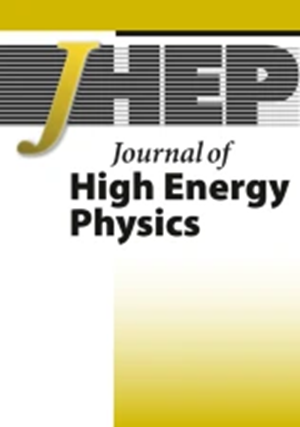Sharpening the A → Z(*)h signature of the Type-II 2HDM at the LHC through advanced Machine Learning
IF 5.5
1区 物理与天体物理
Q1 PHYSICS, PARTICLES & FIELDS
引用次数: 0
Abstract
A bstract The A → Z (*) h decay signature has been highlighted as possibly being the first testable probe of the Standard Model (SM) Higgs boson discovered in 2012 ( h ) interacting with Higgs companion states, such as those existing in a 2-Higgs Doublet Model (2HDM), chiefly, a CP-odd one ( A ). The production mechanism of the latter at the Large Hadron Collider (LHC) takes place via $$ b\overline{b} $$利用先进的机器学习技术锐化LHC ii型2HDM的A→Z(*)h特征
A→Z (*) h衰变特征被强调为可能是2012年发现的标准模型(SM)希格斯玻色子(h)与希格斯伴生态相互作用的第一个可测试探测,例如存在于2-希格斯双重态模型(2HDM)中的那些,主要是一个cp奇数(A)。后者在大型强子对撞机(LHC)上的产生机制是通过$$ b\overline{b} $$ b¯湮灭和/或gg -聚变发生的,这取决于2HDM参数,而这又取决于这个超越SM (BSM)场景的汤川结构。在可能的2HDM版本中,我们在这里测试所谓的Type-II,有两个原因。一方面,有趣的是,它提供了两个非常不同的参数区域,符合类标准希格斯测量,即,所谓的2HDM的“标准SM极限”可以实现。另一方面,在这两种配置中,AZh耦合通常很小,因此信号受到背景的强烈污染,因此机器学习(ML)技术的利用变得非常有用。在本文中,我们证明了高级机器学习实现的应用对于建立这样的信号是决定性的。这对于涉及A→Z (*) h衰减的所有不同的运动学构型都是正确的,即低于阈值(m A <m Z + m h),在其最大值(m Z + m h <m &;2 m t)和接近$$ t\overline{t} $$ t t¯对生产(m A≈2 m t)的开始(m A≈2 m t),我们提出了用于未来现象学分析的基准点(bp)。
本文章由计算机程序翻译,如有差异,请以英文原文为准。
求助全文
约1分钟内获得全文
求助全文
来源期刊

Journal of High Energy Physics
PHYSICS, PARTICLES & FIELDS-
CiteScore
10.00
自引率
46.30%
发文量
2107
审稿时长
12 weeks
期刊介绍:
The aim of the Journal of High Energy Physics (JHEP) is to ensure fast and efficient online publication tools to the scientific community, while keeping that community in charge of every aspect of the peer-review and publication process in order to ensure the highest quality standards in the journal.
Consequently, the Advisory and Editorial Boards, composed of distinguished, active scientists in the field, jointly establish with the Scientific Director the journal''s scientific policy and ensure the scientific quality of accepted articles.
JHEP presently encompasses the following areas of theoretical and experimental physics:
Collider Physics
Underground and Large Array Physics
Quantum Field Theory
Gauge Field Theories
Symmetries
String and Brane Theory
General Relativity and Gravitation
Supersymmetry
Mathematical Methods of Physics
Mostly Solvable Models
Astroparticles
Statistical Field Theories
Mostly Weak Interactions
Mostly Strong Interactions
Quantum Field Theory (phenomenology)
Strings and Branes
Phenomenological Aspects of Supersymmetry
Mostly Strong Interactions (phenomenology).
 求助内容:
求助内容: 应助结果提醒方式:
应助结果提醒方式:


